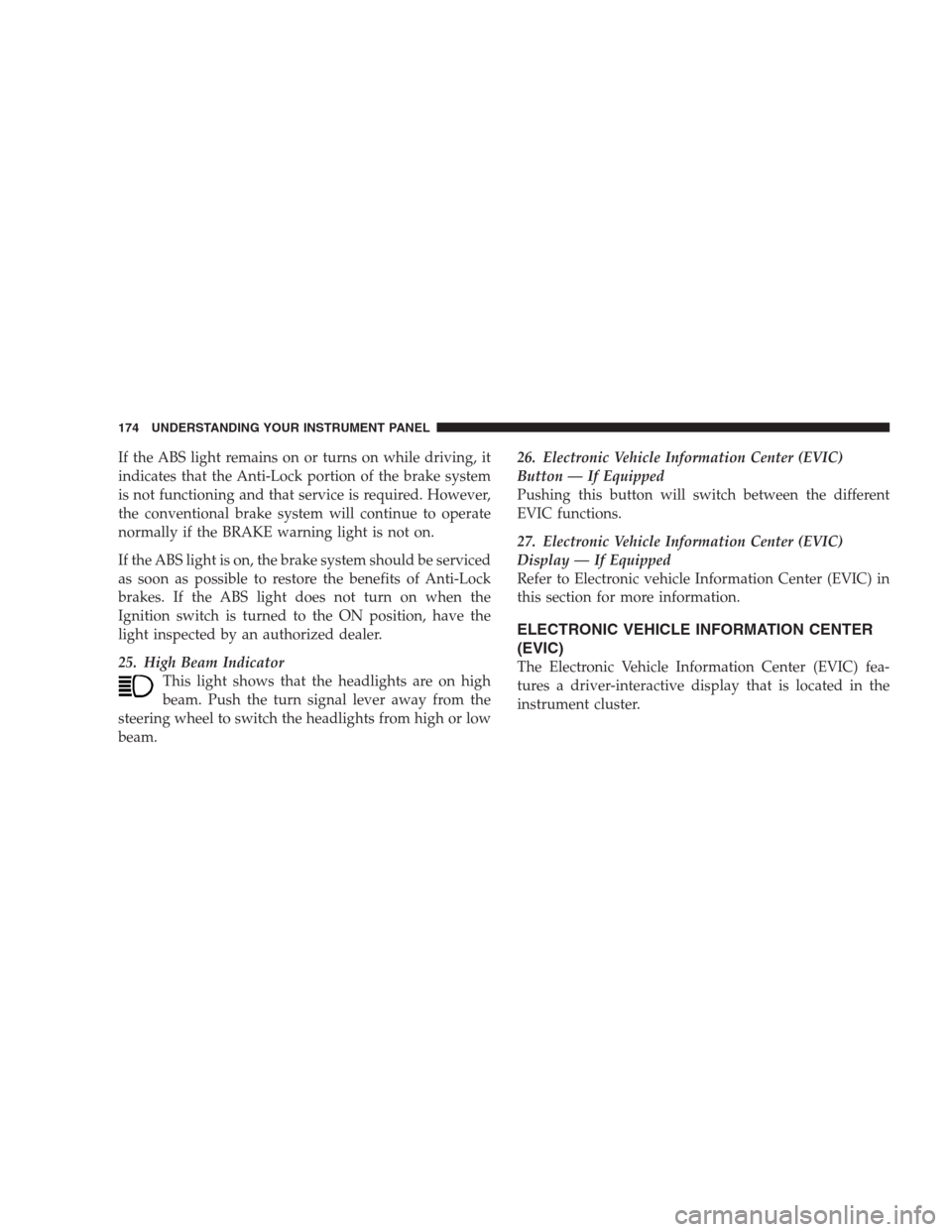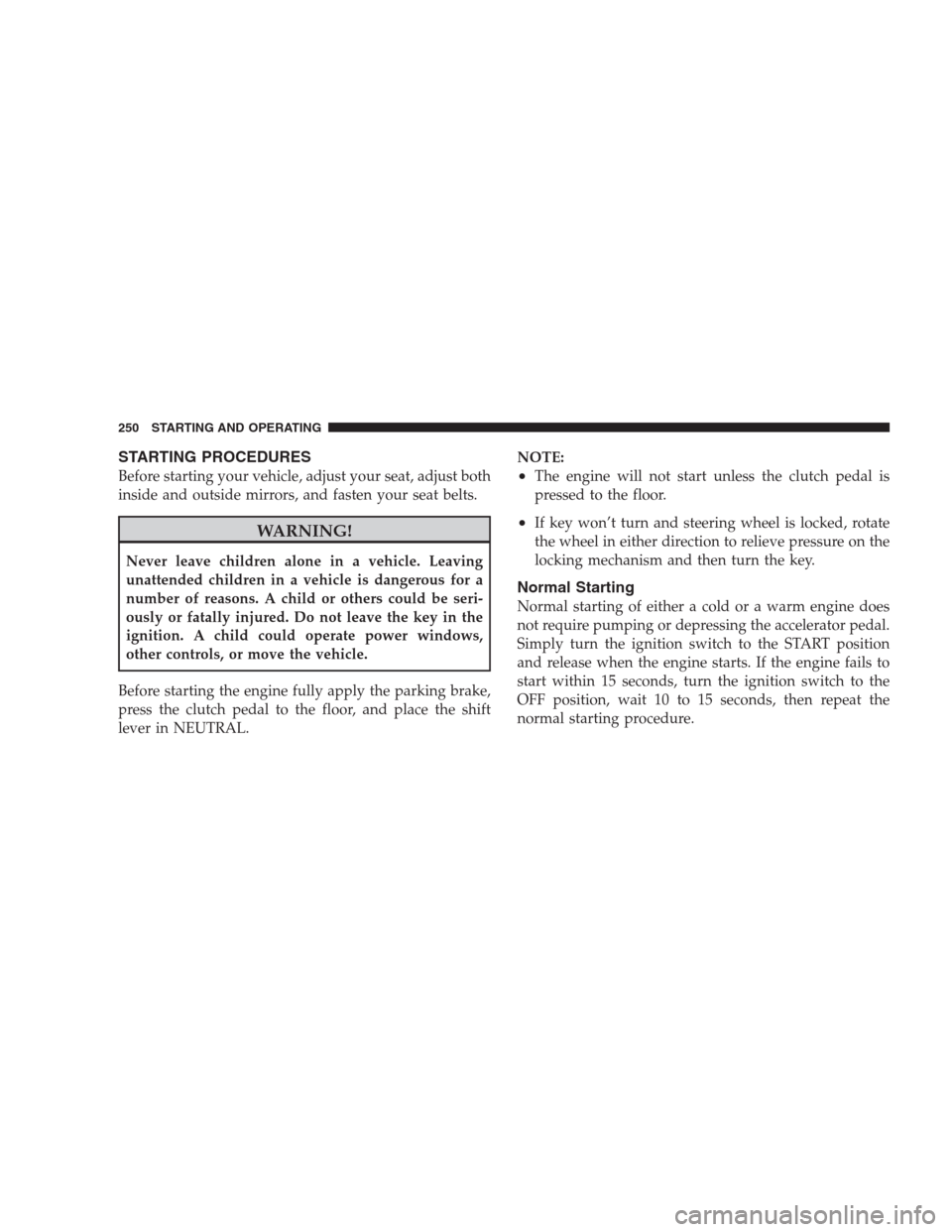Page 176 of 411

If the ABS light remains on or turns on while driving, it
indicates that the Anti-Lock portion of the brake system
is not functioning and that service is required. However,
the conventional brake system will continue to operate
normally if the BRAKE warning light is not on.
If the ABS light is on, the brake system should be serviced
as soon as possible to restore the benefits of Anti-Lock
brakes. If the ABS light does not turn on when the
Ignition switch is turned to the ON position, have the
light inspected by an authorized dealer.
25. High Beam Indicator
This light shows that the headlights are on high
beam. Push the turn signal lever away from the
steering wheel to switch the headlights from high or low
beam.26. Electronic Vehicle Information Center (EVIC)
Button — If Equipped
Pushing this button will switch between the different
EVIC functions.
27. Electronic Vehicle Information Center (EVIC)
Display — If Equipped
Refer to Electronic vehicle Information Center (EVIC) in
this section for more information.
ELECTRONIC VEHICLE INFORMATION CENTER
(EVIC)
The Electronic Vehicle Information Center (EVIC) fea-
tures a driver-interactive display that is located in the
instrument cluster.
174 UNDERSTANDING YOUR INSTRUMENT PANEL
Page 181 of 411

Braking Distance
When the braking distance EVIC screen is active, the
vehicle braking distance and speed at which the brake
was depressed will be displayed. This feature is available
for braking that begins at a speed over 30 mph (48 kp/h).
•The mph (kp/h) and ft (m) text will flash when the
conditions are met to begin a braking event. While a
braking event is taking place, the starting speed and
current distance will be shown.
•The feature will be disabled if the park brake is
engaged.
•The braking distance measurement will be aborted if
the brake is released before the vehicle comes to a
complete stop.
0-60 mph (0-100 kp/h)
When the 0-60 mph (100 kp/h) screen is active, the time
that the vehicle takes to reach 60 mph (100 kp/h) will be
displayed.
•The feature will “ready” when the vehicle is at 0 mph.
The SEC text will flash indicating that conditions are
met for the event to begin.
•If the vehicle does not reach 60 mph (100 kp/h) in less
then 10 seconds, the display will revert back to dashes.
•Pressing the trip button will display the vehicle best
time to 60 mph (100 kp/h).
•To clear the vehicle best, hold the TRIP button, then
press and release the EVIC button. This will reset the
best and current values.
UNDERSTANDING YOUR INSTRUMENT PANEL 179
4
Page 249 of 411
STARTING AND OPERATING
CONTENTS
�Starting Procedures.................... 250
▫Normal Starting..................... 250
▫Extremely Cold Weather (Below -20°F Or
-29°C)............................. 251
▫If Engine Fails To Start................. 251
▫After Starting....................... 252
▫Turbocharger “Cool Down”............. 252
�Manual Transaxle...................... 252
▫Downshifting....................... 253�Driving On Slippery Surfaces............. 254
▫Acceleration........................ 254
▫Traction........................... 254
�Driving Through Water.................. 255
▫Flowing/Rising Water................. 255
▫Shallow Standing Water................ 255
�Power Steering........................ 257
▫Power Steering Fluid Check............. 258
�Parking Brake........................ 259
5
Page 250 of 411

�Brake System......................... 260
▫Anti-Lock Brake System (ABS) — If
Equipped.......................... 261
�Electronic Brake Control System........... 264
▫Traction Control System (TCS)........... 264
▫Brake Assist System (BAS).............. 264
▫Electronic Stability Program (ESP)......... 265
�Tire Safety Information.................. 270
▫Tire Markings....................... 270
▫Tire Identification Number (TIN).......... 274
▫Tire Loading And Tire Pressure........... 275
�Tires — General Information.............. 279
▫Tire Pressure........................ 279▫Tire Inflation Pressures................. 280
▫Radial-Ply Tires...................... 282
▫Tire Spinning....................... 282
▫Tread Wear Indicators................. 283
▫Life Of Tire......................... 284
▫Replacement Tires.................... 284
�Tire Chains.......................... 285
�Snow Tires.......................... 286
�Tire Rotation Recommendations............ 286
�Tire Pressure Monitoring System (TPMS)..... 287
▫Base System........................ 290
▫Premium System — If Equipped.......... 292
▫General Information................... 296
248 STARTING AND OPERATING
Page 252 of 411

STARTING PROCEDURES
Before starting your vehicle, adjust your seat, adjust both
inside and outside mirrors, and fasten your seat belts.
WARNING!
Never leave children alone in a vehicle. Leaving
unattended children in a vehicle is dangerous for a
number of reasons. A child or others could be seri-
ously or fatally injured. Do not leave the key in the
ignition. A child could operate power windows,
other controls, or move the vehicle.
Before starting the engine fully apply the parking brake,
press the clutch pedal to the floor, and place the shift
lever in NEUTRAL.NOTE:
•The engine will not start unless the clutch pedal is
pressed to the floor.
•If key won’t turn and steering wheel is locked, rotate
the wheel in either direction to relieve pressure on the
locking mechanism and then turn the key.
Normal Starting
Normal starting of either a cold or a warm engine does
not require pumping or depressing the accelerator pedal.
Simply turn the ignition switch to the START position
and release when the engine starts. If the engine fails to
start within 15 seconds, turn the ignition switch to the
OFF position, wait 10 to 15 seconds, then repeat the
normal starting procedure.
250 STARTING AND OPERATING
Page 254 of 411

CAUTION!
To prevent damage to the starter, do not crank the
engine for more than 15 seconds at a time. Wait 10 to
15 seconds before trying again.
After Starting
The idle speed will automatically decrease as the engine
warms up.
Turbocharger “Cool Down”
This vehicle is equipped with an after-run pump to cool
the turbocharger after the engine is shut off. Depending
on the type of driving and the amount of cargo, the pump
will run for up to 10 minutes after the engine has been
shut off to circulate coolant through the turbocharger.
Although the pump is rubber-mounted for quiet opera-
tion, it is normal to hear it running during this time.
MANUAL TRANSAXLE
WARNING!
You or others could be injured if you leave the
vehicle unattended without having the parking
brake fully applied. The parking brake should al-
ways be applied when the driver is not in the vehicle,
especially on an incline.
Fully depress the clutch pedal before you shift gears. As
you release the clutch pedal, lightly depress the accelera-
tor pedal.
252 STARTING AND OPERATING
Page 256 of 411

CAUTION!
If you skip more than one gear while downshifting
or downshift at too high of a vehicle speed, you could
damage the engine, transmission, or clutch.
To maintain a safe speed and prolong brake life, shift
down to 2nd or 1st when descending a steep grade.
When turning a corner, or driving up a steep grade,
downshift early so that the engine will not be
overburdened.
DRIVING ON SLIPPERY SURFACES
Acceleration
Rapid acceleration on snow covered, wet, or other slip-
pery surfaces may cause the front wheels to pull errati-
cally to the right or left. This phenomenon occurs when
there is a difference in the surface traction under the front
(driving) wheels.
WARNING!
Rapid acceleration on slippery surfaces is dangerous.
Unequal traction can cause sudden pulling of the
front wheels. You could lose control of the vehicle
and possibly have an accident. Accelerate slowly and
carefully whenever there is likely to be poor traction
(ice, snow, wet, mud, loose sand, etc.).
Traction
When driving on wet or slushy roads, it is possible for a
wedge of water to build up between the tire and road
surface. This is hydroplaning and may cause partial or
complete loss of vehicle control and stopping ability. To
reduce this possibility, the following precautions should
be observed:
1. Slow down during rainstorms or when roads are
slushy.
254 STARTING AND OPERATING
Page 259 of 411

WARNING!
•Driving through standing water limits your vehi-
cle’s traction capabilities. Do not exceed 5 mph
(8 km/h) when driving through standing water.
•Driving through standing water limits your vehi-
cle’s braking capabilities, which increases stop-
ping distances. Therefore, after driving through
standing water, drive slowly and lightly press on
the brake pedal several times to dry the brakes.
•Getting water inside your vehicle’s engine can
cause it to lock up and stall out, and leave you
stranded.
•Failure to follow these warnings may result in
injuries that are serious or fatal to you, your
passengers, and others around you.
POWER STEERING
The standard power steering system will give you good
vehicle response and increased ease of maneuverability
in tight spaces. The system will provide mechanical
steering capability if power assist is lost.
If for some reason the power assist is interrupted, it will
still be possible to steer your vehicle. Under these condi-
tions, you will observe a substantial increase in steering
effort, especially at very low vehicle speeds and during
parking maneuvers.
NOTE:Increased noise levels at the end of the steering
wheel travel are considered normal and do not indicate
that there is a problem with the power steering system.
Upon initial start-up in cold weather, the power steering
pump may make noise for a short amount of time. This is
due to the cold, thick fluid in the steering system. This
noise should be considered normal, and it does not in any
way damage the steering system.
STARTING AND OPERATING 257
5